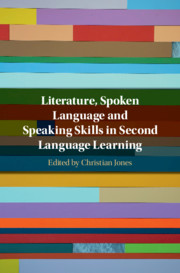Book contents
- Literature, Spoken Language and Speaking Skills in Second Language Learning
- Literature, Spoken Language and Speaking Skills in Second Language Learning
- Copyright page
- Contents
- Figures and Tables
- Contributors
- Foreword
- Acknowledgements
- 1 Introduction
- Part I Literature and Spoken Language
- 2 The Realism of Conversation in Literature
- 3 Using Literature in Text-Driven Materials to Help Develop Spoken Language Awareness
- 4 Literature, TV Drama and Spoken Language Awareness
- 5 Haiku and Spoken Language: Corpus-Driven Analyses of Linguistic Features in English Language Haiku Writing
- 6 Screenplays as a Pedagogical Medium for Cultivating EFL Learners’ Metapragmatic Awareness of Speech Acts in Spoken English
- Part II Literature and Speaking Skills
- Index
- References
5 - Haiku and Spoken Language: Corpus-Driven Analyses of Linguistic Features in English Language Haiku Writing
from Part I - Literature and Spoken Language
Published online by Cambridge University Press: 18 October 2019
- Literature, Spoken Language and Speaking Skills in Second Language Learning
- Literature, Spoken Language and Speaking Skills in Second Language Learning
- Copyright page
- Contents
- Figures and Tables
- Contributors
- Foreword
- Acknowledgements
- 1 Introduction
- Part I Literature and Spoken Language
- 2 The Realism of Conversation in Literature
- 3 Using Literature in Text-Driven Materials to Help Develop Spoken Language Awareness
- 4 Literature, TV Drama and Spoken Language Awareness
- 5 Haiku and Spoken Language: Corpus-Driven Analyses of Linguistic Features in English Language Haiku Writing
- 6 Screenplays as a Pedagogical Medium for Cultivating EFL Learners’ Metapragmatic Awareness of Speech Acts in Spoken English
- Part II Literature and Speaking Skills
- Index
- References
Summary
This chapter reports on a poetic inquiry with English language learners in the Japanese English as a Foreign Language (EFL) university context. It focuses on the use of haiku – a Japanese poem containing seventeen syllables in a three-line 5–7–5 syllable pattern with the usage of a seasonal reference and a cutting word – and analyses features of spoken language in a corpus of English language haiku poetry written by Japanese second language (L2) learners. The chapter begins by reviewing previous studies of the use of haiku in L2 contexts. It then describes a quantitative, corpus-based study which involved the analysis of textual and linguistic features of English language haiku writing. The data, consisting of a total of 2,017 haiku poems written by 204 first-year engineering students at a Japanese public university, were submitted to statistical analyses. The results illustrate some specific features of English language haiku produced by Japanese L2 writers: haiku poetry is a short, descriptive text which presents each writer’s emotional reactions to his or her daily life, and it also includes such spoken language features as the twelve verbs most frequently used in spoken discourse (Biber and Conrad ), evaluative and emotive adjectives, contractions and vague language. This study suggests that the task of composing haiku in English can play an important role in L2 learning in terms of raising learners’ awareness of typical spoken forms in the target language.
Information
- Type
- Chapter
- Information
- Publisher: Cambridge University PressPrint publication year: 2019
References
Accessibility standard: Unknown
Why this information is here
This section outlines the accessibility features of this content - including support for screen readers, full keyboard navigation and high-contrast display options. This may not be relevant for you.Accessibility Information
- 1
- Cited by
